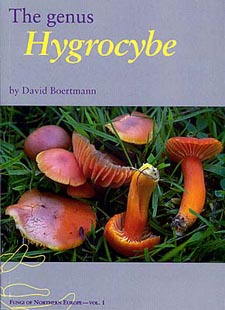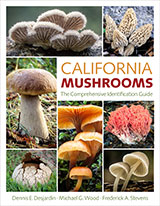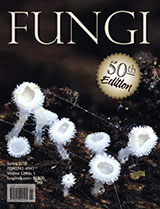Book Review
The Genus Hygrocybe
“With their brilliant colours, Hygrocybe species are among the most spectacular of fungi.” So opens the preface to this most spectacular first volume of the new series Fungi of Northern Europe, published by the Danish Mycological Society. Although David Boertmann is an amateur mycologist, one could never guess it by his work. He has been studying waxcaps for over 20 years and, like many European “amateurs,” has made significant contributions to the taxonomic knowledge in his area of expertise. And now he has made much of that knowledge available in a most excellent way.
 This book covers all 59 species and varieties recognized by Boertmann from the Alps to northern Norway, with special emphasis, not surprisingly, on Denmark. The northern Atlantic islands, Iceland, and Greenland are also included. Of the included taxa, over half have been reported from North America so the book will be useful here as a supplement to our own monographs such as North American Species of Hygrophorus by Hesler and Smith, and Agaricales of California—Hygrophoraceae by David Largent.
This book covers all 59 species and varieties recognized by Boertmann from the Alps to northern Norway, with special emphasis, not surprisingly, on Denmark. The northern Atlantic islands, Iceland, and Greenland are also included. Of the included taxa, over half have been reported from North America so the book will be useful here as a supplement to our own monographs such as North American Species of Hygrophorus by Hesler and Smith, and Agaricales of California—Hygrophoraceae by David Largent.
After the preface, Boertmann presents an introduction that summarizes his methodology, a taxonomic description of Hygrocybe (as is obvious from the title, he considers it a genus, although many mycologists consider it a section of the genus Hygrophorus) covering both the macroscopic and microscopic features, and his systematic arrangement of taxa within the genus. He then discusses the importance of hygrocybes as indicators of grassland habitat quality (in northern Europe hygrocybes occur most abundantly in unfertilized grasslands, which are disappearing there). Although this will have little direct utility in North America, using mushrooms as ecological indicators is an interesting concept that probably could be applied for certain of our own threatened habitats.
Next, he presents three keys—the first based on macroscopic features and suitable for field use, the second based on macroscopic and microscopic characters, and the third a synoptic key to those species that have features that set them apart clearly from the other taxa. Following this, he comments on illustrations of hygrocybes in a number of other European publications. Taxonomic disagreements aside, his comments illustrate that it’s best not to take any book as fungal gospel!
The main section of the book contains the descriptions, and here’s where it really shines. Each species receives at least two pages which include a comprehensive but succinct description, comments on ecology and distribution, and a discussion of the taxon in relation to possible lookalikes and other taxonomists’ concepts. Amateur mycologists will appreciate that Boertmann uses fairly broad species concepts. Illustrations for each taxon include very high quality color photographs that are particularly effective for identification, a distribution map, and drawings of spores. The discussions don’t offer many comments on edibility because Hygrocybe pratensis is the only species Boertmann recommends eating. Besides, they’re too pretty to eat anyway!
All-in-all, this is a first-class effort. Beautiful, professionally presented, and just the right amount of information to give all of us a fighting chance to identify these eye-catching fungi. I recommend it highly and am looking forward to future volumes on Lactarius, Tricholoma, and Hebeloma.
— Review by Steve Trudell, Seattle, WA
— Originally published in The Mycophile 39:6, 1998


